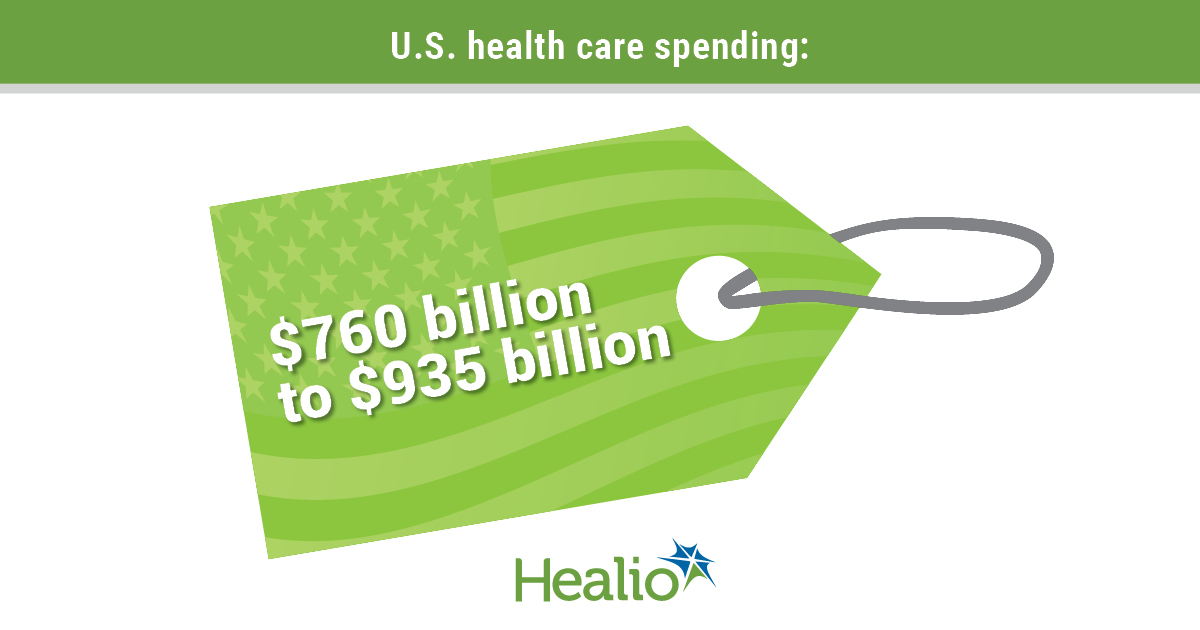Up to $935B wasted in health care spending annually

The estimated cost of waste in the United States health care system ranged from $760 billion to $935 billion annually, or about 25% of total health care spending, according to an analysis published in JAMA.
Researchers said waste reduction interventions ranged from a minimum of between $191 billion to and $282 billion annually.
In their analysis, the researchers reviewed 71 estimates from 54 different sources in the literature. A breakdown of the waste and savings from interventions that researchers found included:
- Administrative complexity was responsible for $265.6 billion of waste. The researchers were unable to find studies that focused on interventions targeting administrative complexity.
- Pricing failure was responsible for $230.7 billion to $240.5 billion of waste, and interventions in this area could have saved $81.4 billion to $91.2 billion.
- Failure of care delivery was responsible for $102.4 billion to $165.7 billion of waste, and interventions in this area could saved $44.4 billion to $93.3 billion.
- Overtreatment and low-value care were responsible for $75.7 billion to $101.2 billion of waste, and interventions in this area could have saved $12.8 billion to $28.6 billion.
- Fraud and abuse were responsible for $58.5 billion to $83.9 billion in waste, and interventions in this area could have saved $22.8 billion to $30.8 billion.
- Failure of care coordination was responsible for $27.2 billion to $78.2 billion in waste, and interventions in this could have saved $29.6 billion to $38.2 billion.

William H. Shrank, MD, MSHS, study co-author and chief medical officer of Humana, told Healio Primary Care that the amount attributed to administrative complexity waste was “striking” and presented “a real opportunity for improvement.”
“By embracing the call for data interoperability and expanding value-based payments models such as rewarding doctors for higher quality care and better outcomes rather than for the number of services they provide, we can reduce the complexity, paperwork and friction that distracts us from care provision,” he said.
“Clinicians should adopt technologies that enable every patient touchpoint to be visible to the health care team and to better support holistic care management that includes physical, behavioral and social needs of patients,” Shrank added.
A similar analysis, published in 2012, found that 34% of health care spending was wasted, according to Shrank and colleagues. That review did not include possible savings.
Donald M. Berwick, MD, MPP, president emeritus at the Institute for Healthcare Improvement, wrote in a related editorial that the lower end of the “massive” amount of waste that is close to Medicare and Medicaid’s annual budget.
He noted that on a local scale, physicians can reduce waste by reducing overtreatment, improving care coordination, making care safer, revising the Choosing Wisely campaign in a “bolder” fashion and advocating for shared risk and global payment reimbursement systems.
Berwick added that politics is the most likely reason for the waste, and mitigating that factor requires a larger effort.
“Physicians can and should act with strong voices and political courage to openly oppose greed and deception in pricing policies wherever they arise,” he wrote.
In a second editorial, Karen E. Joynt Maddox, MD, MPH, co-director of the Center for Health Economics and Policy at the Institute for Public Health at Washington University, St. Louis, and colleagues discussed other factors for the finite savings.
They blamed “generally complex” payment models, and “inadequate alignment” of the current value-based and alternative payment models, adding that these systems lack clinician support and fail to create a “sustainable business case” for restructuring care; waste interventions that are sometimes expensive and the “elephant in the room:” hospital costs.
Joynt Maddox and colleagues suggested changes that move “primary care toward a capitated payment system with a streamlined set of quality measures and financial supports for keeping people healthy and out of the hospital” could lower the cost of waste.
They added that “specialty care will likely need a combination of a primary care–like chronic disease management track and add-on ‘bundles’ for procedures, with quality measures relevant to specialized care comprising the core of quality measurement. Hospital care should be structured within such bundles where feasible, with clear quality measures around safety.” – by Janel Miller
References:
Berwick DM. JAMA. 2019;doi:10.1001/jama.2019.14610.
Joynt Maddox KE, et al. JAMA. 2019;doi:10.1001/jama.2019.13977.
Shrank WH, et al. JAMA. 2019;doi:10.1001/jama.2019.13978.
Disclosures: Berwick reports no relevant financial disclosures. Joynt Maddox receives research support from the National Heart, Lung, and Blood Institute; National Institute on Aging and Commonwealth Fund; and previously did contract work for HHS. Shrank reports receiving support from Humana. Please see the study and editorials for all other authors’ relevant financial disclosures.

